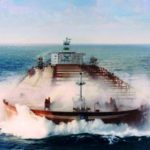
TThe tanker market can face significant consequences of the potential for US steps against Chinese-made vessels. In his latest weekly report, Shipbroker Gibson said that “this week, many in the shipping industry are likely to hear about the section 301 of the US Trade Law for the first time. This provision allows the US to overcome the practice of unfair foreign trade that affects US trade. Last year, the US Trade Representative (USTR) launched an investigation of the practice of shipbuilding and maritime China, concluded in January 2025 that China was involved in unfair practices. As a result, the USTR has published a proposed action plan and received public comments until March 24 “.

Source: Gibson Shipbroker
According to Gibson, “This proposal is very aggressive, displaying a high cost that is not proportional. This outlines several complex options targeting Chinese operators and/or ships made in China, including those according to orders. The final proposal can combine one or more of these steps. In particular, the definition of “operator” is still unclear – it can refer to entities that have or effectively control the ship. Unclear words, may be intentional, leaving space for interpretation “.
“In the case of steps under the USTR action plan, the first part includes a proposal to collect Chinese operators A $ 1MLN per US port entry. The second part proposes to charge up to $ 1.5mln for a port call by any Chinese -made ship. In this size, there is also an option to adjust the lower total cost, depending on the percentage of ships made in China in the operator fleet, although it is not clear whether this is an additional or not the cost of $ 1.5 mln flat. The third size is targeting orders in Chinese yards, with the highest proposed cost set at $ 1 million for port calls for operators that have more than 50% or 25% of their order book in the Chinese yard “.

Gibson said that “With 20-25% of the global tanker fleet above 25,000 DWT (excluding LR1/Panamaxes) built in China, tanker operators face significant exposure to this potential change. Chinese operators are very vulnerable, because one part of the proposal specifically selects it. It should be noted that Chinese companies have at least 15% of the Global VLCC fleet, even though their ownership parts are much smaller in other tanker segments “.
“The impact of the market will depend on which steps – or a combination of actions – are applied. Steps that focus directly on Chinese operators and/or only Chinese-made ships without referring to the operator fleet are likely to be less disturbing compared to those who consider the overall composition of the operator fleet. Considering that US crude oil exports and imports contribute 9% and 7% of global trade, respectively, and net exports of 13%, the tanker market has sufficient flexibility to relocate Chinese-made tonnage or Chinese-owned tonnage from the US port. However, this is likely to cause inefficiencies, initial disturbances, and missed trading opportunities. The tariff of goods for US -bound trips can rise because of limited ship availability. The size targeting new manufacturing orders may have the same impact. While the majority of tanker orders are in the Chinese yard, this order only represents 11% of the existing fleet, which means that only certain owners will be affected, “said the ship.
Gibson concluded that “the most disturbing action is that connecting the sentence with the Chinese -made ship in the operator’s fleet. At present, more than 60% of the global tanker fleet is owned by companies with at least one ship built in China, while 40% of owners have at least 25% of their fleet built in China. If implemented, this action will have in -depth implications for the tariff of goods related to the US, the Arbitration economy, and even domestic oil and the price of the product is smooth. Each final version of the USTR is likely to lead to discount values for ships made in China and premiums for Korean and Japanese ships, while company orders can change. It can also provide incentives to operators to divide their fleet into smaller entities to minimize US exposure. There are still many that are uncertain, and a clearer picture will appear after the March 24 consultation period. Given that this policy was decided under Trump’s administration, the market can be understood that it can take a more aggressive form “.
Nikos Roussanoglou, Hellenic Shipping News worldwide




